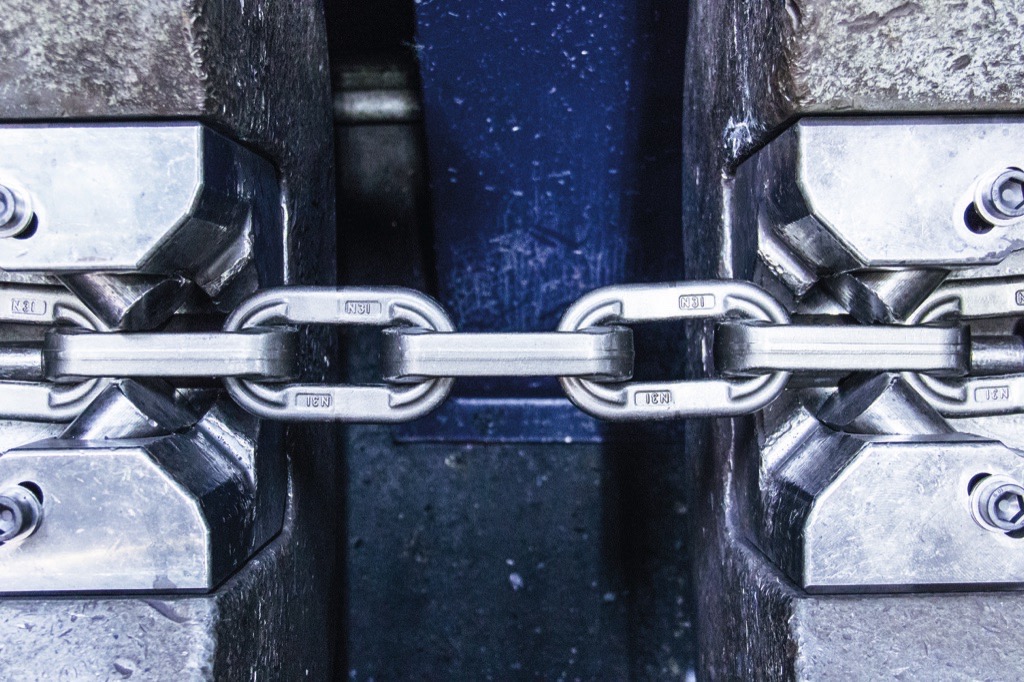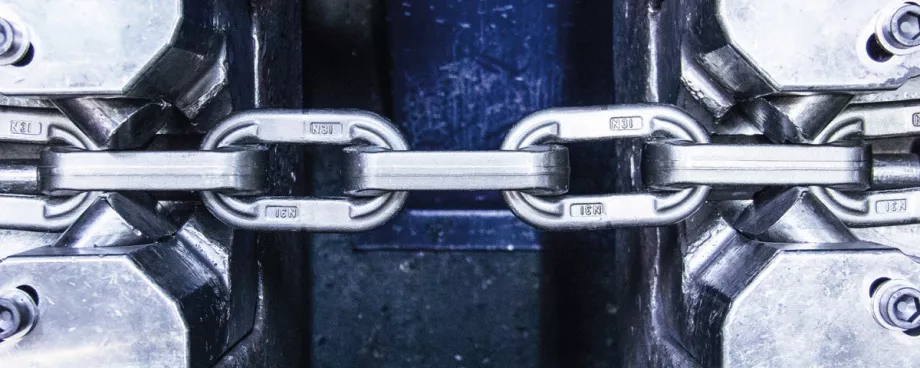For decades, chains have been manufactured using the same old method: by cutting wire rod or rod steel, bending the round steel to the required shape of the chain link and subjecting it to energy-intensive resistance or flash-butt welding. Restricting factors to this conventional technology are at first the shape of the chain links that can only be manufactured from round material, and furthermore the weldability of the steel grades used, which is largely dependent on the carbon content and the alloying elements.Electric resistance welding, of which flash-butt welding is a sub-form, first became popular in the late 19th century during the course of the electrification of Europe and was applied to the manufacturing of round chains, for example. All variations of this welding technique require high currents to melt the material at the welding point, followed by the application of axial force to press and fuse the ends of the open chain link together.Since then, man has developed the combustion engine, figured out how to produce energy from atoms, how to fly planes and rockets and seen the advent of the Internet age – round-steel chains, however, are still manufactured just as they were 100 years ago.For Pewag, a premium chain manufacturer whose roots go back to a forge factory in Brückl, that was first mentioned in documents dating back to 1479, this was reason enough to develop an innovative process for the next generation of chains.But what technology could take the place of traditional chain welding? How could the restriction “function follows form” that applies with the use of round steel be circumvented?Looking at the automotive sector for inspiration, we can see that a wide range of vehicle types have developed over the decades since cars first began to be manufactured on an industrial level. Each vehicle type has a certain purpose: Sports cars are designed to reach high speeds, family cars to provide space, and trucks for the transportation of large-volume, heavy loads. Form follows function.Conveyor chains must comply with different demands to snow chains, lifting or hoisting chains. They must have a high level of tensile strength, be case-hardened to minimise wear and, despite these contradictory characteristics, also offer the highest possible level of operational safety and a long life cycle.To create a new chain generation, a technology had to be found that would permit a high level of freedom with regard to shaping and materials.

Friction Welding – Form follows Function
Friction welding is a tried-and-tested “joining technology” that has been used by the aviation and automotive industries for decades. The method also allows for the joining of lightweight construction materials such as aluminium with high-strength steels, which is not possible with conventional welding techniques, and mechanical joining methods have to be applied to achieve this goal. With friction welding, such materials can be joined without having to compromise when it comes to weld stability or having to accept a higher weight.Pewag is the first chain manufacturer worldwide to have taken up the innovative technology of friction welding and refined it for the manufacture of the next generation of chains. Unlike conventional round-steel chains, the friction-welded chain does not start out as wire rod or rod steel, but consists exclusively of forged parts. By using forged components, there is no the risk of tension cracks, which are a typical by-product of the cold-bending process of round-steel chains.Friction welding as such is not a conventional welding technique. In friction welding, heat is generated through mechanical friction between the links to be joined, which causes the material to plasticise. A defined lateral force is applied to fuse the components to a whole chain link with precise pitch and strand lengths.
Benefits of Friction Welding
Friction welding is a joining technique that does not require the melting of the parts to be joined, which means that the solidus temperature is never exceeded. The materials to be joined plasticise under the influence of friction and lateral force, but do not melt. One benefit of this is that the typical grain formation of metals entering from the liquid into the solid phase is eliminated.Unlike electric resistance welding, where steel is heated in an energy-intensive process that requires high currents, the heating process in friction welding is completed exclusively by means of mechanical friction, a low-energy process where heat development is strictly localised, thereby practically eliminating hardness peaks and crack formation.Generally, traditional welding techniques require clean surfaces of the parts to be joined to achieve a good welding quality. Dirt or other contaminations can cause the chain link to crack unexpectedly under load. In friction welding, on the other hand, contaminations have no effects on quality. Any dirt remaining on the surfaces or parts to be joined will be pressed into the welding seam during the plasticisation process of the material that results from the friction and the lateral forces that are applied, thus removing it from the weld.As mentioned earlier, there are practically no restrictions as to what materials may be subjected to friction welding. Even steels that are regarded as “unweldable” using traditional welding methods may be joined using friction welding techniques. A good example is 50CrV4 steel, which is ideally suited for conveyor chain applications thanks to its excellent wear resistance properties.Form must follow function! It was this principle that inspired pewag to design the pewag hero conveyor chain. The critical factors of conveyor chains can be summarised as service life and operational reliability as well as tensile strength.As a significantly prolonged service life entails not just lower costs per operating hour, but also increases productivity as chains need to be replaced less frequently, pewag hero provides additional wear volume that is more than twice as large as that of a conventional round-steel chain.To fulfil the demands placed in an ideal conveyor chain, a chain link geometry was chosen that aims at providing the smallest possible contact pressure between the chain links and moves the “unused” volume of round-steel chains to where it is needed the most. Despite all these newly incorporated benefits, the weight of the chains has been kept the same.And although Pewag hero no longer has much in common with a classic round-steel chain, its design was chosen in such a way that it runs with all conventional geared and ungeared wheels and is compatible with all pewag chain locks, bucket and scraper fastenings.
| About the Author | |
| Markus Seibnerpewag Austria GmbH, Austria |
■







